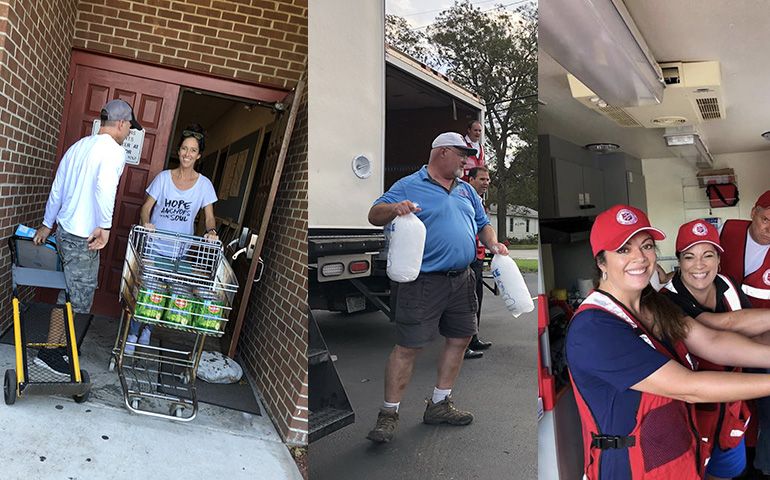Disaster Response Requires Many "C's"
Karen Yoho | karen.yoho@uss.salvationarmy.org | (202) 577-3143

Washington, NC (September 20, 2018) -- “We need more cutlery.” “We could use a box of clam shells.” “Anyone have extra box of condiments?” These are the three C’s of The Salvation Army mobile feeding units, also known as “canteens.” (Yet another “C.”)
As hot food, snacks, and water is packed onto the canteens, supplies such as these are a necessity. In response to Hurricane Florence, the Army has served drinks and snacks, provided shelter and emotional and spiritual care, and more than 80,000 meals. That’s a lot of cutlery, clam shells, and condiments! And for those of you unaware, those are plastic forks, knives and spoons, foam food containers, and packages of ketchup and mustard.
But there is one more essential “C” that comes into play when The Salvation Amy responds: Community. With more than 7,600 centers of operation in the U.S., The Salvation Army is uniquely positioned to support survivors of wide-scale disasters because they’re often first on the scene, and stay until the need is met.
As The Salvation Army of Washington, North Carolina, monitored reports of the approaching storm last week, calls began coming in to offer assistance.
- The older Washington Corps building did not have a commercial ice machine to fill canteen coolers and provide to neighbors. Washington Crab & Oyster Company offered to move an ice locker to the building. As crews headed out to serve meals, where homes had not had power for at least three days, more ice was needed. Washington Crab & Oyster owner, Tony Tripp, brought a box truck full of 300 bags of ice to the site where The Salvation Army was serving 600 meals to residents of Aurora.
- A local food pantry, Eagle’s Wings, invited Salvation Army canteens to come and load up more than 2,000 snack items to distribute to neighbors.
- Covenant Church in Washington has members of their congregation living in hard-hit areas, but those same individuals were giving back. A crew of church members loaded pallets of food received through the USDA and donations of snack items from a local food pantry and delivered to the Virginia Baptist Disaster Response Kitchen.
- And one last example is all about timing. Jennifer Waterfield, a sales representative from CopyPro was in the Corps office before the storm hit. When the rains and wind died down, she contacted the Corps with an offer to serve. After their volunteer applications were processed, Jennie and her sister Melissa, helped with canteen operations in Aurora.
As the floodwaters begin to subside in the areas hardest hit by Hurricane Florence, with the help of generous contributions, The Salvation Army can meet the immediate needs of communities.
How to help:
- Online: helpsalvationarmy.org
- Donate by phone: 1-800-SAL-ARMY
- Mail checks to: The Salvation Army, P.O. BOX 1959, Atlanta, GA 30301
Please designate '2018 Hurricane Season - Florence' on all checks. - To receive a donation link via text: Text STORM to 51555
- You can now use ALEXA to donate to The Salvation Army Hurricane Florence Relief.
Just say, “Hey Alexa, make a donation to The Salvation Army!”
The Salvation Army annually helps more than 30 million Americans overcome poverty, addiction, and economic hardships through a range of social services. By providing food for the hungry, emergency relief for disaster survivors, rehabilitation for those suffering from drug and alcohol abuse, and clothing and shelter for people in need, The Salvation Army is doing the most good at 7,600 centers of operation around the country. In the first-ever listing of “America’s Favorite Charities” by The Chronicle of Philanthropy, The Salvation Army ranked as the country’s largest privately funded, direct-service nonprofit. For more information, visit www.SalvationArmyUSA.org. Follow us on Twitter @SalvationArmyUS and #DoingTheMostGood.